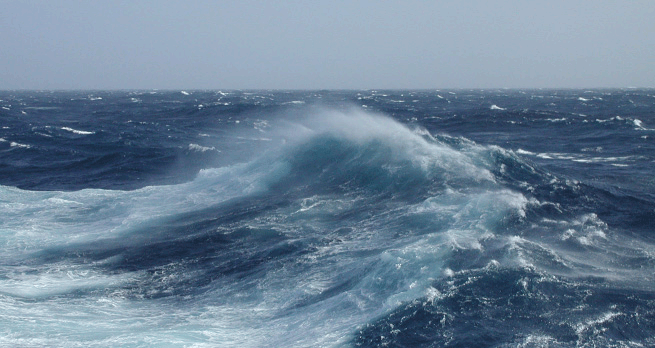3.1 Salt in the oceans
The saltiness in seawater is due to a mixture of many different ionic constituents. If you boiled away 1 kg of seawater in a pan you would find, on average, 34.482 g of solid material left. (You would probably end up with less salt as some ionic constituents would form gases.) Almost 99.95% of the total mass of this solid material is made up of the constituents listed in Table 2.
| Ion | % by mass of 34.482 g | Weight/g kg−1 |
|---|---|---|
| Chloride Cl− | 55.04 | 18.980 |
| Sulfate SO42− | 7.68 | 2.649 |
| Hydrogen carbonate, HCO3− | 0.41 | 0.140 |
| Bromide, Br− | 0.19 | 0.065 |
| Borate, H2BO3− | 0.07 | 0.026 |
| Fluoride, F− | 0.003 | 0.001 |
| Sodium, Na+ | 30.61 | 10.556 |
| Magnesium, Mg2+ | 3.69 | 1.272 |
| Calcium, Ca2+ | 1.16 | 0.400 |
| Potassium, K+ | 1.10 | 0.380 |
| Strontium, Sr2+ | 0.04 | 0.013 |
Quantitative analysis of the salt content in different oceans shows that although the total amount of dissolved salt varies from place to place, the major elements are always present in the same relative proportions. This amazing fact is called the principle of constancy of composition.
-
If the ratio of the amounts of the ions of K+ to Cl− in the Atlantic Ocean was 0.02, what would be the ratio of the two ions in the Pacific Ocean?
-
The ratio of the K+ to Cl− ions would be exactly the same at 0.02, because of the constancy of composition of seawater.
The dissolved salts mean that seawater conducts electricity well and conductivity is directly proportional to the salt content. Salinity is defined by comparing the conductivity of a water sample with that of a reference sample of 'standard seawater'. Since salinity is effectively describing a ratio it has no units - but it can be labelled 'practical salinity units' (PSU). In older books and on some websites, you may find salinity expressed in parts per thousand (abbreviated to ppt or given the symbol ‰). While this is technically incorrect, for all practical purposes they are equivalent. The salt composition in the global oceans has not significantly varied in the last 108 years. The residence time of seawater is ~4000 years. So the processes that add salt to the ocean and the processes that remove salt from the ocean must be in balance.
The salinity of seawater of average ocean density is 34.482.
